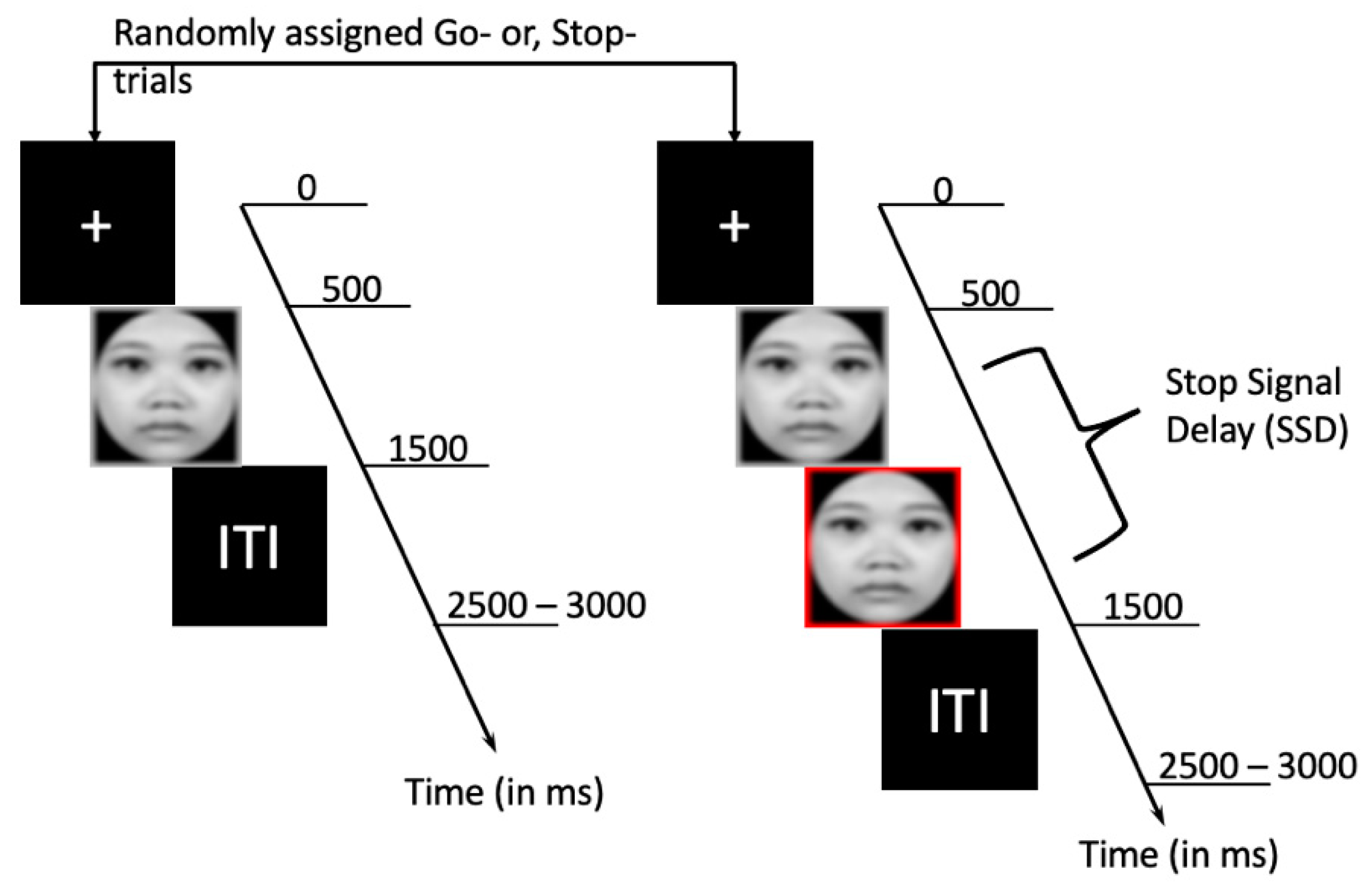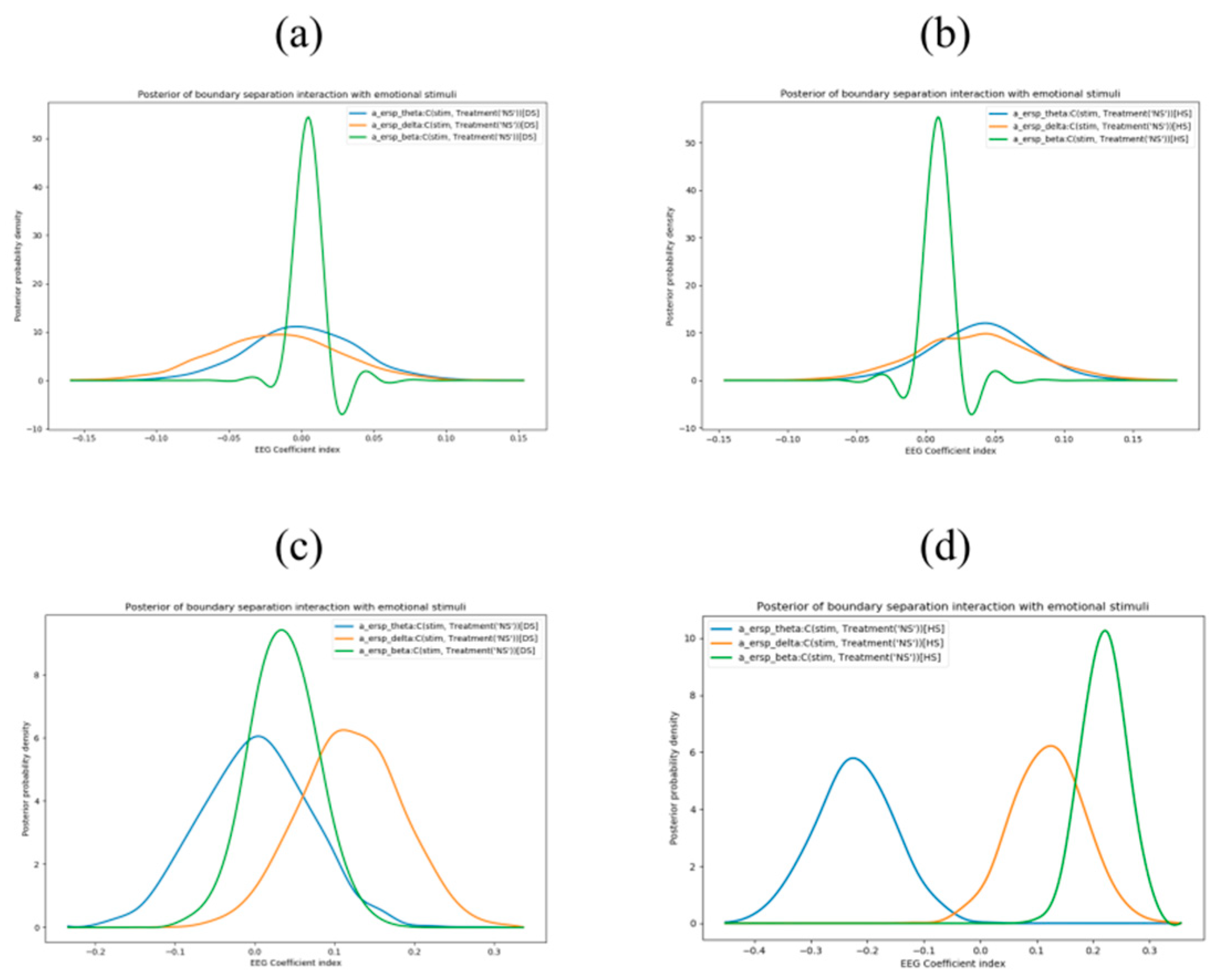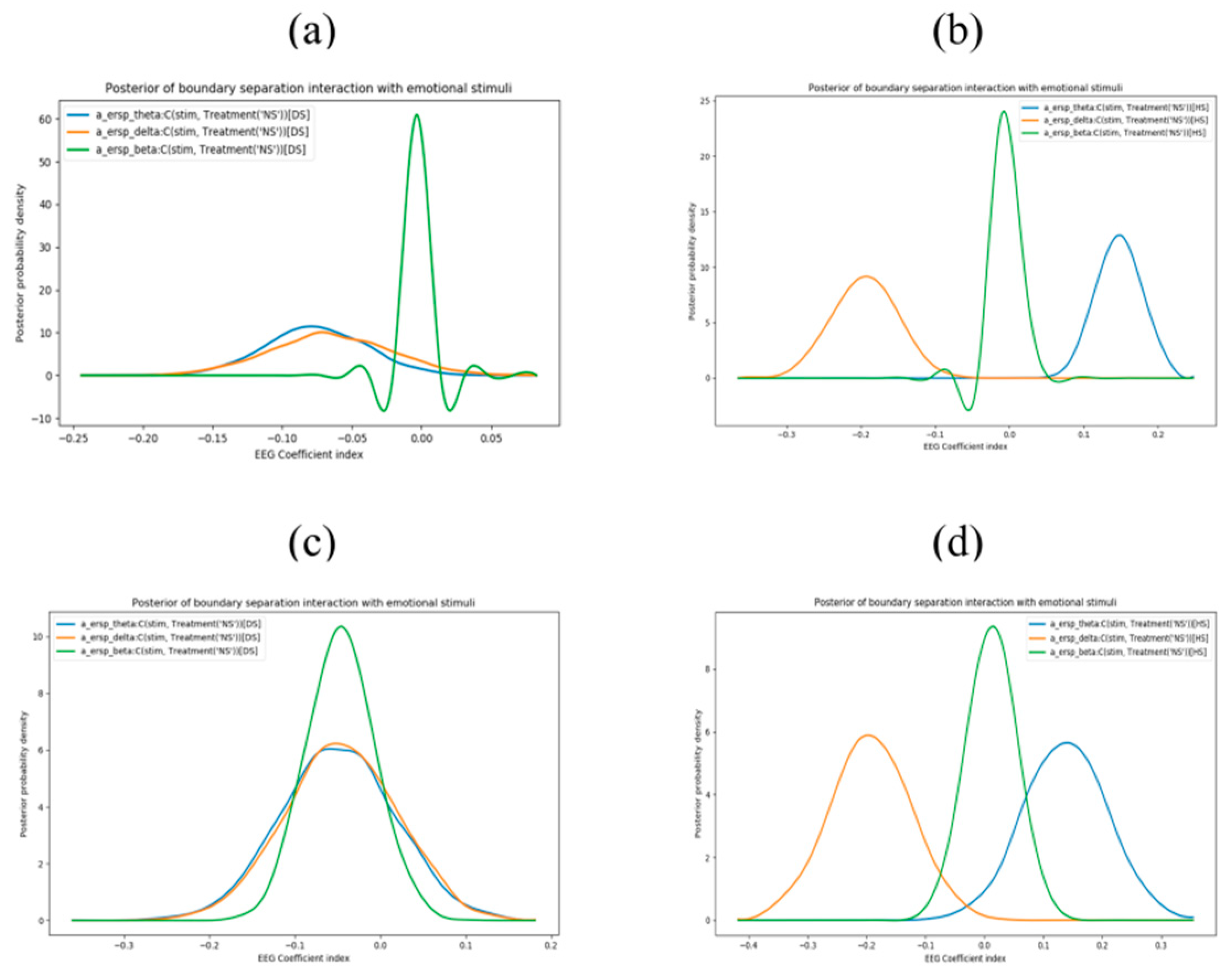Fronto—Parietal Regions Predict Transient Emotional States in Emotion Modulated Response Inhibition via Low Frequency and Beta Oscillations
Abstract
:1. Introduction
2. Materials and Methods
2.1. Participants
2.2. Material and Experimental Design
2.3. Data Collection and Analyses
2.3.1. EEG Recording
2.3.2. EEG Analysis
2.3.3. Hierarchical Drift Diffusion Model (HDDM) Analysis
2.3.4. Statistical Analysis
3. Results
3.1. Behavioral Results
3.2. Linking DDM Parameters with Behavior Data
3.3. Exploring Trial-by-Trial Regression Analysis of ERSP Data with DDM Parameters
4. Discussion
5. Conclusions
Author Contributions
Funding
Institutional Review Board Statement
Informed Consent Statement
Data Availability Statement
Acknowledgments
Conflicts of Interest
Appendix A
- (1)
- For the within-subject regression model of behavior data, the model used was
- (2)
- For the neural regression models, the model used was
References
- Diamond, A. Executive functions. Annu. Rev. Psychol. 2013, 64, 135–168. [Google Scholar] [CrossRef] [PubMed] [Green Version]
- Logan, G.D.; Cowan, W.B. On the ability to inhibit thought and action: A theory of an act of control. Psychol. Rev. 1984, 91, 295. [Google Scholar] [CrossRef]
- Dutra, I.C.; Waller, D.A.; Wessel, J.R. Perceptual surprise improves action stopping by nonselectively suppressing motor activity via a neural mechanism for motor inhibition. J. Neurosci. 2018, 38, 1482–1492. [Google Scholar] [CrossRef]
- Donders, F.C. On the speed of mental processes. Acta Psychol. 1969, 30, 412–431. [Google Scholar] [CrossRef]
- Schachar, R.; Logan, G.D.; Robaey, P.; Chen, S.; Ickowicz, A.; Barr, C. Restraint and cancellation: Multiple inhibition deficits in attention deficit hyperactivity disorder. J. Abnorm. Child Psychol. 2007, 35, 229–238. [Google Scholar] [CrossRef]
- Raud, L.; Westerhausen, R.; Dooley, N.; Huster, R.J. Differences in unity: The go/no-go and stop signal tasks rely on different mechanisms. NeuroImage 2020, 210, 116582. [Google Scholar] [CrossRef]
- Aron, A.R.; Durston, S.; Eagle, D.M.; Logan, G.D.; Stinear, C.M.; Stuphorn, V. Converging evidence for a fronto-basal-ganglia network for inhibitory control of action and cognition. J. Neurosci. 2007, 27, 11860–11864. [Google Scholar] [CrossRef]
- Verbruggen, F.; Logan, G.D. Response inhibition in the stop-signal paradigm. Trends Cogn. Sci. 2008, 12, 418–424. [Google Scholar] [CrossRef] [Green Version]
- Van Belle, J.; Vink, M.; Durston, S.; Zandbelt, B.B. Common and unique neural networks for proactive and reactive response inhibition revealed by independent component analysis of functional MRI data. Neuroimage 2014, 103, 65–74. [Google Scholar] [CrossRef]
- Aron, A.R. From reactive to proactive and selective control: Developing a richer model for stopping inappropriate responses. Biol. Psychiatry 2011, 69, e55–e68. [Google Scholar] [CrossRef] [Green Version]
- Chikazoe, J.; Jimura, K.; Hirose, S.; Yamashita, K.-I.; Miyashita, Y.; Konishi, S. Preparation to inhibit a response complements response inhibition during performance of a stop-signal task. J. Neurosci. 2009, 29, 15870–15877. [Google Scholar] [CrossRef] [PubMed]
- Vink, M.; Kaldewaij, R.; Zandbelt, B.B.; Pas, P.; du Plessis, S. The role of stop-signal probability and expectation in proactive inhibition. Eur. J. Neurosci. 2015, 41, 1086–1094. [Google Scholar] [CrossRef] [PubMed]
- Zandbelt, B.B.; Vink, M. On the role of the striatum in response inhibition. PLoS ONE 2010, 5, e13848. [Google Scholar] [CrossRef] [PubMed]
- Braver, T.S. The variable nature of cognitive control: A dual mechanisms framework. Trends Cogn. Sci. 2012, 16, 106–113. [Google Scholar] [CrossRef] [PubMed] [Green Version]
- Critchley, H.D.; Mathias, C.J.; Dolan, R.J. Neural activity in the human brain relating to uncertainty and arousal during anticipation. Neuron 2001, 29, 537–545. [Google Scholar] [CrossRef] [Green Version]
- Verbruggen, F.; Aron, A.R.; Band, G.P.; Beste, C.; Bissett, P.G.; Brockett, A.T.; Brown, J.W.; Chamberlain, S.R.; Chambers, C.D.; Colonius, H. A consensus guide to capturing the ability to inhibit actions and impulsive behaviors in the stop-signal task. eLife 2019, 8, e46323. [Google Scholar] [CrossRef]
- Zhang, F.; Iwaki, S. Common neural network for different functions: An investigation of proactive and reactive inhibition. Front. Behav. Neurosci. 2019, 13, 124. [Google Scholar] [CrossRef] [Green Version]
- Verbruggen, F.; Logan, G.D. Proactive adjustments of response strategies in the stop-signal paradigm. J. Exp. Psychol. Hum. Percept. Perform. 2009, 35, 835. [Google Scholar] [CrossRef] [Green Version]
- Jahfari, S.; Ridderinkhof, K.R.; Scholte, H.S. Spatial frequency information modulates response inhibition and decision-making processes. PLoS ONE 2013, 8, e76467. [Google Scholar] [CrossRef]
- Langford, Z.D.; Krebs, R.M.; Talsma, D.; Woldorff, M.G.; Boehler, C.N. Strategic down-regulation of attentional resources as a mechanism of proactive response inhibition. Eur. J. Neurosci. 2016, 44, 2095–2103. [Google Scholar] [CrossRef] [Green Version]
- Langford, Z.D.; Schevernels, H.; Boehler, C.N. Motivational context for response inhibition influences proactive involvement of attention. Sci. Rep. 2016, 6, 35122. [Google Scholar] [CrossRef] [Green Version]
- Nayak, S.; Kuo, C.; Tsai, A.C.-H. Mid-Frontal Theta Modulates Response Inhibition and Decision Making Processes in Emotional Contexts. Brain Sci. 2019, 9, 271. [Google Scholar] [CrossRef] [Green Version]
- White, C.N.; Congdon, E.; Mumford, J.A.; Karlsgodt, K.H.; Sabb, F.W.; Freimer, N.B.; London, E.D.; Cannon, T.D.; Bilder, R.M.; Poldrack, R.A. Decomposing decision components in the stop-signal task: A model-based approach to individual differences in inhibitory control. J. Cogn. Neurosci. 2014, 26, 1601–1614. [Google Scholar] [CrossRef] [Green Version]
- Booth, J.R.; Burman, D.D.; Meyer, J.R.; Lei, Z.; Trommer, B.L.; Davenport, N.D.; Li, W.; Parrish, T.B.; Gitelman, D.R.; Mesulam, M.M. Neural development of selective attention and response inhibition. Neuroimage 2003, 20, 737–751. [Google Scholar] [CrossRef]
- Vuilleumier, P. How brains beware: Neural mechanisms of emotional attention. Trends Cogn. Sci. 2005, 9, 585–594. [Google Scholar] [CrossRef]
- Pessoa, L. How do emotion and motivation direct executive control? Trends Cogn. Sci. 2009, 13, 160–166. [Google Scholar] [CrossRef] [Green Version]
- Pourtois, G.; Schettino, A.; Vuilleumier, P. Brain mechanisms for emotional influences on perception and attention: What is magic and what is not. Biol. Psychol. 2013, 92, 492–512. [Google Scholar] [CrossRef] [Green Version]
- Pessoa, L.; Kastner, S.; Ungerleider, L.G. Attentional control of the processing of neutral and emotional stimuli. Cogn. Brain Res. 2002, 15, 31–45. [Google Scholar] [CrossRef]
- Pessoa, L.; Padmala, S.; Kenzer, A.; Bauer, A. Interactions between cognition and emotion during response inhibition. Emotion 2012, 12, 192. [Google Scholar] [CrossRef] [Green Version]
- Pawliczek, C.M.; Derntl, B.; Kellermann, T.; Kohn, N.; Gur, R.C.; Habel, U. Inhibitory control and trait aggression: Neural and behavioral insights using the emotional stop signal task. Neuroimage 2013, 79, 264–274. [Google Scholar] [CrossRef]
- Schel, M.A.; Crone, E.A. Development of response inhibition in the context of relevant versus irrelevant emotions. Front. Psychol. 2013, 4, 383. [Google Scholar] [CrossRef] [Green Version]
- Verbruggen, F.; De Houwer, J. Do emotional stimuli interfere with response inhibition? Evidence from the stop signal paradigm. Cogn. Emot. 2007, 21, 391–403. [Google Scholar] [CrossRef]
- Lindström, B.R.; Bohlin, G. Threat-relevance impairs executive functions: Negative impact on working memory and response inhibition. Emotion 2012, 12, 384. [Google Scholar] [CrossRef]
- Kalanthroff, E.; Cohen, N.; Henik, A. Stop feeling: Inhibition of emotional interference following stop-signal trials. Front. Hum. Neurosci. 2013, 7, 78. [Google Scholar] [CrossRef] [Green Version]
- Rebetez, M.M.L.; Rochat, L.; Billieux, J.; Gay, P.; Van der Linden, M. Do emotional stimuli interfere with two distinct components of inhibition? Cogn. Emot. 2015, 29, 559–567. [Google Scholar] [CrossRef]
- Patterson, T.K.; Lenartowicz, A.; Berkman, E.T.; Ji, D.; Poldrack, R.A.; Knowlton, B.J. Putting the brakes on the brakes: Negative emotion disrupts cognitive control network functioning and alters subsequent stopping ability. Exp. Brain Res. 2016, 234, 3107–3118. [Google Scholar] [CrossRef]
- Huster, R.J.; Enriquez-Geppert, S.; Lavallee, C.F.; Falkenstein, M.; Herrmann, C.S. Electroencephalography of response inhibition tasks: Functional networks and cognitive contributions. Int. J. Psychophysiol. 2013, 87, 217–233. [Google Scholar] [CrossRef]
- Knyazev, G.; Slobodskoj-Plusnin, J.Y.; Bocharov, A. Event-related delta and theta synchronization during explicit and implicit emotion processing. Neuroscience 2009, 164, 1588–1600. [Google Scholar] [CrossRef]
- Swann, N.; Tandon, N.; Canolty, R.; Ellmore, T.M.; McEvoy, L.K.; Dreyer, S.; DiSano, M.; Aron, A.R. Intracranial EEG reveals a time-and frequency-specific role for the right inferior frontal gyrus and primary motor cortex in stopping initiated responses. J. Neurosci. 2009, 29, 12675–12685. [Google Scholar] [CrossRef] [Green Version]
- Schaum, M.; Pinzuti, E.; Sebastian, A.; Lieb, K.; Fries, P.; Mobascher, A.; Jung, P.; Wibral, M.; Tüscher, O. Right inferior frontal gyrus implements motor inhibitory control via beta-band oscillations in humans. eLife 2021, 10, e61679. [Google Scholar] [CrossRef]
- Vandierendonck, A. On the utility of integrated speed-accuracy measures when speed-accuracy trade-off is present. J. Cogn. 2021, 4, 22. [Google Scholar] [CrossRef]
- Herz, D.M.; Tan, H.; Brittain, J.-S.; Fischer, P.; Cheeran, B.; Green, A.L.; FitzGerald, J.; Aziz, T.Z.; Ashkan, K.; Little, S. Distinct mechanisms mediate speed-accuracy adjustments in cortico-subthalamic networks. eLife 2017, 6, e21481. [Google Scholar] [CrossRef] [Green Version]
- Herz, D.M.; Zavala, B.A.; Bogacz, R.; Brown, P. Neural correlates of decision thresholds in the human subthalamic nucleus. Curr. Biol. 2016, 26, 916–920. [Google Scholar] [CrossRef] [Green Version]
- Cavanagh, J.F.; Zambrano-Vazquez, L.; Allen, J.J. Theta lingua franca: A common mid-frontal substrate for action monitoring processes. Psychophysiology 2012, 49, 220–238. [Google Scholar] [CrossRef] [Green Version]
- Cavanagh, J.F.; Wiecki, T.V.; Cohen, M.X.; Figueroa, C.M.; Samanta, J.; Sherman, S.J.; Frank, M.J. Subthalamic nucleus stimulation reverses mediofrontal influence over decision threshold. Nat. Neurosci. 2011, 14, 1462–1467. [Google Scholar] [CrossRef]
- Frank, M.J.; Gagne, C.; Nyhus, E.; Masters, S.; Wiecki, T.V.; Cavanagh, J.F.; Badre, D. fMRI and EEG predictors of dynamic decision parameters during human reinforcement learning. J. Neurosci. 2015, 35, 485–494. [Google Scholar] [CrossRef] [Green Version]
- Aron, A.R.; Behrens, T.E.; Smith, S.; Frank, M.J.; Poldrack, R.A. Triangulating a cognitive control network using diffusion-weighted magnetic resonance imaging (MRI) and functional MRI. J. Neurosci. 2007, 27, 3743–3752. [Google Scholar] [CrossRef] [Green Version]
- Forstmann, B.U.; Anwander, A.; Schäfer, A.; Neumann, J.; Brown, S.; Wagenmakers, E.-J.; Bogacz, R.; Turner, R. Cortico-striatal connections predict control over speed and accuracy in perceptual decision making. Proc. Natl. Acad. Sci. USA 2010, 107, 15916–15920. [Google Scholar] [CrossRef] [Green Version]
- Lambert, C.; Zrinzo, L.; Nagy, Z.; Lutti, A.; Hariz, M.; Foltynie, T.; Draganski, B.; Ashburner, J.; Frackowiak, R. Confirmation of functional zones within the human subthalamic nucleus: Patterns of connectivity and sub-parcellation using diffusion weighted imaging. Neuroimage 2012, 60, 83–94. [Google Scholar] [CrossRef] [Green Version]
- Bogacz, R.; Wagenmakers, E.-J.; Forstmann, B.U.; Nieuwenhuis, S. The neural basis of the speed–accuracy tradeoff. Trends Neurosci. 2010, 33, 10–16. [Google Scholar] [CrossRef]
- Heathcote, A.; Lin, Y.-S.; Reynolds, A.; Strickland, L.; Gretton, M.; Matzke, D. Dynamic models of choice. Behav. Res. Methods 2019, 51, 961–985. [Google Scholar] [CrossRef] [PubMed]
- Weigard, A.; Sripada, C. Task-General Efficiency of Evidence Accumulation as a Computationally Defined Neurocognitive Trait: Implications for Clinical Neuroscience. Biol. Psychiatry Glob. Open Sci. 2021, 1, 5–15. [Google Scholar] [CrossRef] [PubMed]
- Battaglia, S.; Serio, G.; Scarpazza, C.; D’Ausilio, A.; Borgomaneri, S. Frozen in (e) motion: How reactive motor inhibition is influenced by the emotional content of stimuli in healthy and psychiatric populations. Behav. Res. Ther. 2021, 146, 103963. [Google Scholar] [CrossRef]
- Bekker, E.M.; Kenemans, J.L.; Hoeksma, M.R.; Talsma, D.; Verbaten, M.N. The pure electrophysiology of stopping. Int. J. Psychophysiol. 2005, 55, 191–198. [Google Scholar] [CrossRef]
- Kok, A.; Ramautar, J.R.; De Ruiter, M.B.; Band, G.P.; Ridderinkhof, K.R. ERP components associated with successful and unsuccessful stopping in a stop-signal task. Psychophysiology 2004, 41, 9–20. [Google Scholar] [CrossRef]
- Boehler, C.N.; Münte, T.F.; Krebs, R.M.; Heinze, H.-J.; Schoenfeld, M.A.; Hopf, J.-M. Sensory MEG responses predict successful and failed inhibition in a stop-signal task. Cereb. Cortex 2009, 19, 134–145. [Google Scholar] [CrossRef] [Green Version]
- Wessel, J.R. Prepotent motor activity and inhibitory control demands in different variants of the go/no-go paradigm. Psychophysiology 2018, 55, e12871. [Google Scholar] [CrossRef]
- Wessel, J.R.; Aron, A.R. It’s not too late: The onset of the frontocentral P 3 indexes successful response inhibition in the stop-signal paradigm. Psychophysiology 2015, 52, 472–480. [Google Scholar] [CrossRef] [Green Version]
- Steinemann, N.A.; O’Connell, R.G.; Kelly, S.P. Decisions are expedited through multiple neural adjustments spanning the sensorimotor hierarchy. Nat. Commun. 2018, 9, 3627. [Google Scholar] [CrossRef] [Green Version]
- Groen, I.I.; Jahfari, S.; Seijdel, N.; Ghebreab, S.; Lamme, V.A.; Scholte, H.S. Scene complexity modulates degree of feedback activity during object detection in natural scenes. PLoS Comput. Biol. 2018, 14, e1006690. [Google Scholar] [CrossRef] [Green Version]
- Tu, Y.-Z.; Lin, D.-W.; Suzuki, A.; Goh, J.O.S. East Asian young and older adult perceptions of emotional faces from an age-and sex-fair east Asian facial expression database. Front. Psychol. 2018, 9, 2358. [Google Scholar] [CrossRef] [PubMed]
- Delorme, A.; Makeig, S. EEGLAB: An open source toolbox for analysis of single-trial EEG dynamics including independent component analysis. J. Neurosci. Methods 2004, 134, 9–21. [Google Scholar] [CrossRef] [PubMed] [Green Version]
- Grandchamp, R.; Delorme, A. Single-trial normalization for event-related spectral decomposition reduces sensitivity to noisy trials. Front. Psychol. 2011, 2, 236. [Google Scholar] [CrossRef] [PubMed] [Green Version]
- Senderecka, M. Threatening visual stimuli influence response inhibition and error monitoring: An event-related potential study. Biol. Psychol. 2016, 113, 24–36. [Google Scholar] [CrossRef] [PubMed]
- Ratcliff, R.; McKoon, G. The diffusion decision model: Theory and data for two-choice decision tasks. Neural Comput. 2008, 20, 873–922. [Google Scholar] [CrossRef] [Green Version]
- Wiecki, T.V.; Sofer, I.; Frank, M.J. HDDM: Hierarchical Bayesian estimation of the drift-diffusion model in Python. Front. Neuroinformatics 2013, 7, 14. [Google Scholar] [CrossRef] [Green Version]
- Williams, S.E.; Lenze, E.J.; Waring, J.D. Positive information facilitates response inhibition in older adults only when emotion is task-relevant. Cogn. Emot. 2020, 34, 1632–1645. [Google Scholar] [CrossRef]
- Carretié, L. Exogenous (automatic) attention to emotional stimuli: A review. Cogn. Affect. Behav. Neurosci. 2014, 14, 1228–1258. [Google Scholar] [CrossRef] [Green Version]
- Cohen, M.X. A neural microcircuit for cognitive conflict detection and signaling. Trends Neurosci. 2014, 37, 480–490. [Google Scholar] [CrossRef]
- Matzke, D.; Logan, G.D.; Heathcote, A. A cautionary note on evidence-accumulation models of response inhibition in the stop-signal paradigm. Comput. Brain Behav. 2020, 3, 269–288. [Google Scholar] [CrossRef] [Green Version]
- Yau, Y.; Hinault, T.; Taylor, M.; Cisek, P.; Fellows, L.K.; Dagher, A. Evidence and urgency related EEG signals during dynamic decision-making in humans. J. Neurosci. 2021, 41, 5711–5722. [Google Scholar] [CrossRef] [PubMed]



| Go Reaction Time (RT) | Stop Signal Reaction Time (SSRT) | |
|---|---|---|
| Negative block | ||
| Disgust | 672.5 ± 99.3 | 313.7 ± 56.6 |
| Neutral | 689.7 ± 95.0 | 327.8 ± 55.1 |
| Positive block | ||
| Happy | 662.5 ± 110.0 | 309.9 ± 59.7 |
| Neutral | 680.2 ± 99.1 | 321.8 ± 49.41 |
| Disgust Go DDM_a | Neutral Go DDM_a | Disgust Go DDM_v | Neutral Go DDM_v | Disgust Go DDM_t0 | Neutral Go DDM_t0 | ||
|---|---|---|---|---|---|---|---|
| Disgust Go RT | Correlation | 0.872 ** | 0.814 ** | −0.671 ** | −0.534 ** | 0.517 ** | 0.405 * |
| Sig. (2-tailed) | 0.000 | 0.000 | 0.000 | 0.001 | 0.002 | 0.019 | |
| Neutral Go RT | Correlation | 0.749 ** | 0.824 ** | −0.700 ** | −0.609 ** | 0.409 * | 0.451 ** |
| Sig. (2-tailed) | 0.000 | 0.000 | 0.000 | 0.000 | 0.018 | 0.008 | |
| Disgust Stop SSRT | Correlation | 0.762 ** | 0.641 ** | −0.670 ** | −0.472 ** | 0.274 | 0.319 |
| Sig. (2-tailed) | 0.000 | 0.000 | 0.000 | 0.006 | 0.123 | 0.070 | |
| Neutral Stop SSRT | Correlation | 0.364 * | 0.498 ** | −0.640 ** | −0.511 ** | −0.037 | 0.245 |
| Sig. (2-tailed) | 0.037 | 0.003 | 0.000 | 0.002 | 0.839 | 0.169 |
| Happy Go DDM_a | Neutral Go DDM_a | Happy Go DDM_v | Neutral Go DDM_v | Happy Go DDM_t0 | Neutral Go DDM_t0 | ||
|---|---|---|---|---|---|---|---|
| Happy Go RT | Correlation | 0.929 ** | 0.892 ** | −0.329 | −0.570 ** | 0.628 ** | 0.475 ** |
| Sig. (2-tailed) | 0.000 | 0.000 | 0.066 | 0.001 | 0.000 | 0.006 | |
| Neutral Go RT | Correlation | 0.894 ** | 0.922 ** | −0.311 | −0.551 ** | 0.635 ** | 0.550 ** |
| Sig. (2-tailed) | 0.000 | 0.000 | 0.083 | 0.001 | 0.000 | 0.001 | |
| Happy Stop SSRT | Correlation | 0.686 ** | 0.713 ** | −0.413 * | −0.576 ** | 0.415 * | 0.242 |
| Sig. (2-tailed) | 0.000 | 0.000 | 0.019 | 0.001 | 0.018 | 0.181 | |
| Neutral Stop SSRT | Correlation | 0.564 ** | 0.668 ** | −0.349 * | −0.496 ** | 0.368 * | 0.313 |
| Sig. (2-tailed) | 0.001 | 0.000 | 0.050 | 0.004 | 0.038 | 0.081 |
Publisher’s Note: MDPI stays neutral with regard to jurisdictional claims in published maps and institutional affiliations. |
© 2022 by the authors. Licensee MDPI, Basel, Switzerland. This article is an open access article distributed under the terms and conditions of the Creative Commons Attribution (CC BY) license (https://creativecommons.org/licenses/by/4.0/).
Share and Cite
Nayak, S.; Tsai, A.C. Fronto—Parietal Regions Predict Transient Emotional States in Emotion Modulated Response Inhibition via Low Frequency and Beta Oscillations. Symmetry 2022, 14, 1244. https://doi.org/10.3390/sym14061244
Nayak S, Tsai AC. Fronto—Parietal Regions Predict Transient Emotional States in Emotion Modulated Response Inhibition via Low Frequency and Beta Oscillations. Symmetry. 2022; 14(6):1244. https://doi.org/10.3390/sym14061244
Chicago/Turabian StyleNayak, Siddharth, and Arthur C. Tsai. 2022. "Fronto—Parietal Regions Predict Transient Emotional States in Emotion Modulated Response Inhibition via Low Frequency and Beta Oscillations" Symmetry 14, no. 6: 1244. https://doi.org/10.3390/sym14061244
APA StyleNayak, S., & Tsai, A. C. (2022). Fronto—Parietal Regions Predict Transient Emotional States in Emotion Modulated Response Inhibition via Low Frequency and Beta Oscillations. Symmetry, 14(6), 1244. https://doi.org/10.3390/sym14061244






